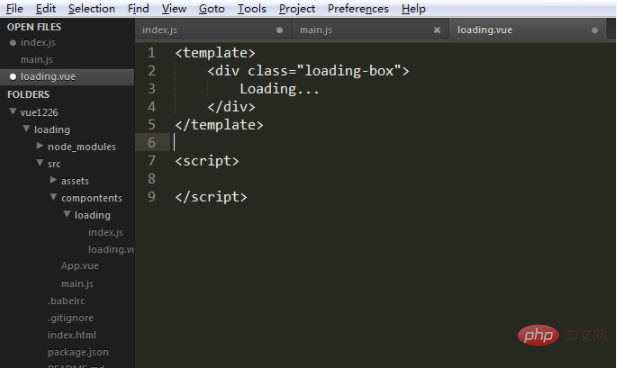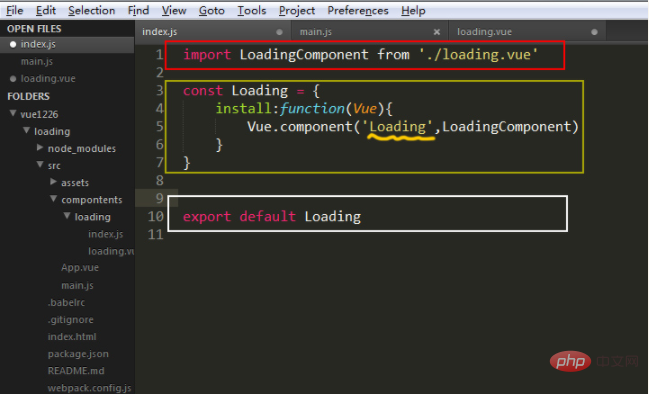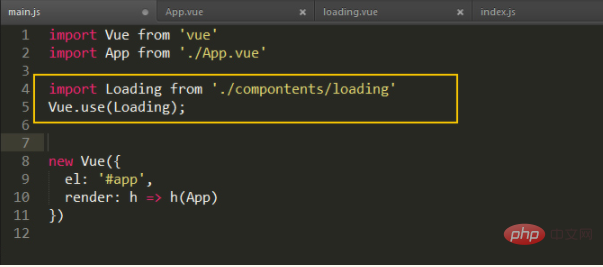How to define custom components in vue
How to define custom components in vue: first create a loading effect component; then create a related [.js] file; finally insert the component into the [<loading></loading>] tag Just inside.

The operating environment of this tutorial: Windows 7 system, Vue version 2.9.6, Dell G3 computer. This method is suitable for all brands of computers.
How to define custom components in vue:
1. First create the component file. Here I assume that we want to create a loading effect component of our own. Then we first Create loading.vue The code inside can be written according to the relevant rules of vue template. I won’t go into details here. I will only write the simplest example

2. We create a related .js file. Usually components have one function and one folder. Then each component should have its own independent calling file (one pot of rice and one pot). So for the sake of unification, we can call them index.js of course. You can choose this name as you like, and you can just change the related name in subsequent calls! Here comes the point: how is this pot made? Without further ado, let’s just go to the picture.

So what are the three inconsistent boxes above? The red box: I don’t need to ask. Which file do you call? You have to tell the world. Of course, we must call the loading.vue file we created just now. Yellow frame: I rely on this yellow frame to be the key point in this article. Why do you say that? If we want to use our own components, we must export this component, and the code in this yellow frame is to export the corresponding configuration of our own components. The very obscene wavy line is the "lifeblood" of this example. This name is the name you use to call this component (here is the loading component) in other files. In this example, when we call the component, we can write <loading></loading>. White frame: There is nothing to say about this. It is equivalent to exporting this component and it is easy to accept in main!
3. The raw material rice is also available, and the rice pot is also available. Now everything is ready. All we need is the east wind. Then our third part is one word "cook" and two words: "fire". This is where we want to create our own For details on how to apply the component to our page, please see the picture below

The yellow framed part is to introduce the component just defined and apply this component in the main file main.js !
Finally, you can insert this component wherever you want to use it<loading></loading>The corresponding style and js code of the component can be written directly in the first step among the files in! It’s such a joy to use a component you created yourself!
Related free learning recommendations: javascript (video)
The above is the detailed content of How to define custom components in vue. For more information, please follow other related articles on the PHP Chinese website!

Hot AI Tools

Undresser.AI Undress
AI-powered app for creating realistic nude photos

AI Clothes Remover
Online AI tool for removing clothes from photos.

Undress AI Tool
Undress images for free

Clothoff.io
AI clothes remover

AI Hentai Generator
Generate AI Hentai for free.

Hot Article

Hot Tools

Notepad++7.3.1
Easy-to-use and free code editor

SublimeText3 Chinese version
Chinese version, very easy to use

Zend Studio 13.0.1
Powerful PHP integrated development environment

Dreamweaver CS6
Visual web development tools

SublimeText3 Mac version
God-level code editing software (SublimeText3)

Hot Topics
 1378
1378
 52
52
 How to add functions to buttons for vue
Apr 08, 2025 am 08:51 AM
How to add functions to buttons for vue
Apr 08, 2025 am 08:51 AM
You can add a function to the Vue button by binding the button in the HTML template to a method. Define the method and write function logic in the Vue instance.
 How to reference js file with vue.js
Apr 07, 2025 pm 11:27 PM
How to reference js file with vue.js
Apr 07, 2025 pm 11:27 PM
There are three ways to refer to JS files in Vue.js: directly specify the path using the <script> tag;; dynamic import using the mounted() lifecycle hook; and importing through the Vuex state management library.
 How to use watch in vue
Apr 07, 2025 pm 11:36 PM
How to use watch in vue
Apr 07, 2025 pm 11:36 PM
The watch option in Vue.js allows developers to listen for changes in specific data. When the data changes, watch triggers a callback function to perform update views or other tasks. Its configuration options include immediate, which specifies whether to execute a callback immediately, and deep, which specifies whether to recursively listen to changes to objects or arrays.
 How to use bootstrap in vue
Apr 07, 2025 pm 11:33 PM
How to use bootstrap in vue
Apr 07, 2025 pm 11:33 PM
Using Bootstrap in Vue.js is divided into five steps: Install Bootstrap. Import Bootstrap in main.js. Use the Bootstrap component directly in the template. Optional: Custom style. Optional: Use plug-ins.
 How to return to previous page by vue
Apr 07, 2025 pm 11:30 PM
How to return to previous page by vue
Apr 07, 2025 pm 11:30 PM
Vue.js has four methods to return to the previous page: $router.go(-1)$router.back() uses <router-link to="/" component window.history.back(), and the method selection depends on the scene.
 Vue realizes marquee/text scrolling effect
Apr 07, 2025 pm 10:51 PM
Vue realizes marquee/text scrolling effect
Apr 07, 2025 pm 10:51 PM
Implement marquee/text scrolling effects in Vue, using CSS animations or third-party libraries. This article introduces how to use CSS animation: create scroll text and wrap text with <div>. Define CSS animations and set overflow: hidden, width, and animation. Define keyframes, set transform: translateX() at the beginning and end of the animation. Adjust animation properties such as duration, scroll speed, and direction.
 How to query the version of vue
Apr 07, 2025 pm 11:24 PM
How to query the version of vue
Apr 07, 2025 pm 11:24 PM
You can query the Vue version by using Vue Devtools to view the Vue tab in the browser's console. Use npm to run the "npm list -g vue" command. Find the Vue item in the "dependencies" object of the package.json file. For Vue CLI projects, run the "vue --version" command. Check the version information in the <script> tag in the HTML file that refers to the Vue file.
 How to use vue pagination
Apr 08, 2025 am 06:45 AM
How to use vue pagination
Apr 08, 2025 am 06:45 AM
Pagination is a technology that splits large data sets into small pages to improve performance and user experience. In Vue, you can use the following built-in method to paging: Calculate the total number of pages: totalPages() traversal page number: v-for directive to set the current page: currentPage Get the current page data: currentPageData()




